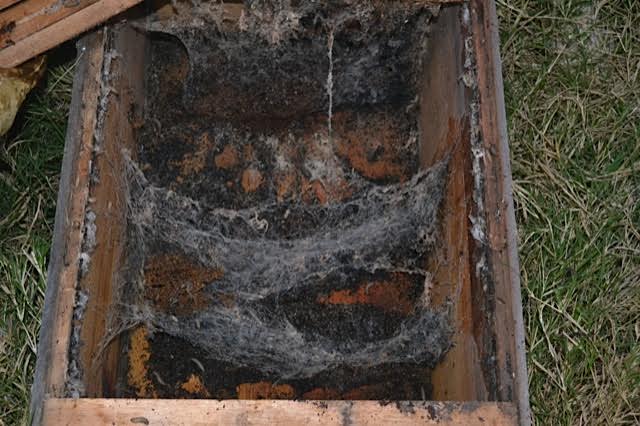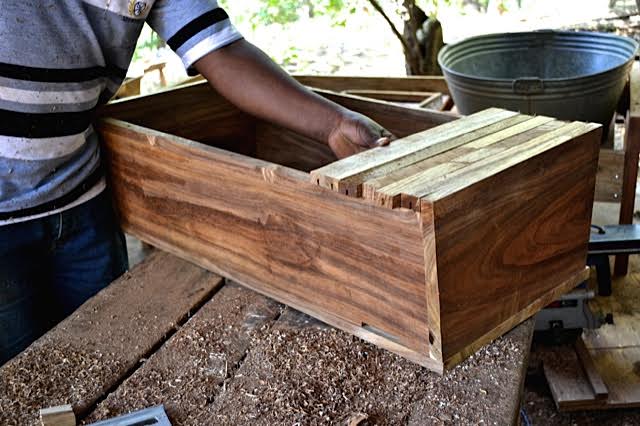Kapenta Harvest May 28-June 2, 2015
|
I had an excellent time working with the Tree of Life beekeeping team harvesting honey the end of May and beginning of June 2015. We harvested from 56 beehives and during that time noticed that the strongest hives came from areas with clay soil and not sandy soils. In clay soils our hives were 70 percent effective in producing large quantities of honey as opposed to only 35-40 percent effective in sandy areas!
During the rainy season we noticed a pronounced effort by both small and large hive beetles to destroy our hives situated in the sandy areas. We believe that this is due to their breeding in the sandy soil types. In our valley this seems to make a difference in the strength of the colony. The most amazing thing we saw during the rains was that large hive beetles were able to get under 7-8 mm entrance excluders. It is assumed by many that 10 mm excluders are the limit for large hive beetles. One of our colonies situated over sandy soil had over 100 large hive beetles attack it and eventually succeeded in the forced absconding of the bees in that colony. |
|
Wax moths were present in the colonies; yet strong colonies kept them very much “in check” and were not adversely affected. The only way to prevent this is to be careful with your space tolerances in the construction of your beehives. Any space in the hive smaller than 4.5 mm was invaded by wax moths. These moths laid their eggs unaffected by the bees too big to enter these spaces and clean them out.
Although the flower bloom was good, it was not excellent like it was back in 2013. The primary flower contributing to the harvest was Lucas Nyassae. It seems that this plant has taken advantage of the slash-and-burn farming going on in Africa to sprout excessively and thrive in the recently deforested land. It takes about 3 years for this plant to occupy cleared farmland in our valley after virgin forest is cleared. It may be the ONLY good thing that comes of the rampant destruction of the forest in the Rukwa Valley. This plant makes excellent honey being of water-white to light amber color depending on what other plants are contributing. |
|
A young man named James monitored our beehives this past year. Since he has been to Manyoni area of Tanzania he has seen that beekeeping can help make an impact on a farmer’s income. Many in Manyoni live by beekeeping alone. Lucas Nyassae is also prevalent there together with many different varieties of bee fodder. For doing weekly-visual inspections of our hives, the leaders of Tree of Life paid James the equivalent of $300 this past year. Any hives not occupied were taken down and re-baited.
|
Many new hives were hung in the forest TWO WEEKS BEFORE SWARM SEASON. This is important, as the beekeeper will get primary swarms in his or her hives which will build rapidly and produce lots of honey and wax. If the hives are hung at a time when small swarms are flying, they will enter and reside there. The queen pheromone given off by the small swarm prevents others from entering and taking up residence. Timing is crucial for beekeepers in getting large fast-building swarms. The hives should be hung two weeks to a month before the swarm season. Swarm season usually peaks during the time the most flowers in the forest are opening up at once. Every area has a time like this. When is yours??? Ask the old men, they will know. Get your hives out then!
|
A few bee lice were seen and a few Varroa but not many. A couple of our colonies were filled with what looked like dead bees but upon closer examination were actually dead hornet-wasps? It seems like the bees occupied the colonies and killed the occupants who obviously entered after colonies of bees absconded during the past year. There were literally thousands in some of the colonies. The bees went on unaffected by the many dead hornet-wasps under them. It was disconcerting seeing the dead, as I was initially afraid thinking they were bees that had died of some disease. Thank God the bees are still strong in Africa!
In terms of the harvest we got 1,158 pounds of honeycomb, which pressed down to 820 pounds of raw liquid honey. It was sold retail for approximately $4 a pound; packaged well and labeled attractively. Tree of Life has no lack of buyers and since good looking and good tasting clean honey is in short supply in Tanzania, it sold right away. |
|
This year was the first year we packaged raw, cut comb in clamshell clear plastic packages. In most of Africa it is seen as a special show of hospitality to serve guests honey from the comb. Best wishes to all the African beekeepers working to impact their economy and local environment! Sincerely, Ted Rabenold Development Director and Beekeeper Trainer for Tree of Life Ltd. (Tanzania) [email protected] africanbeekeeping.com (More pictures follow) |















